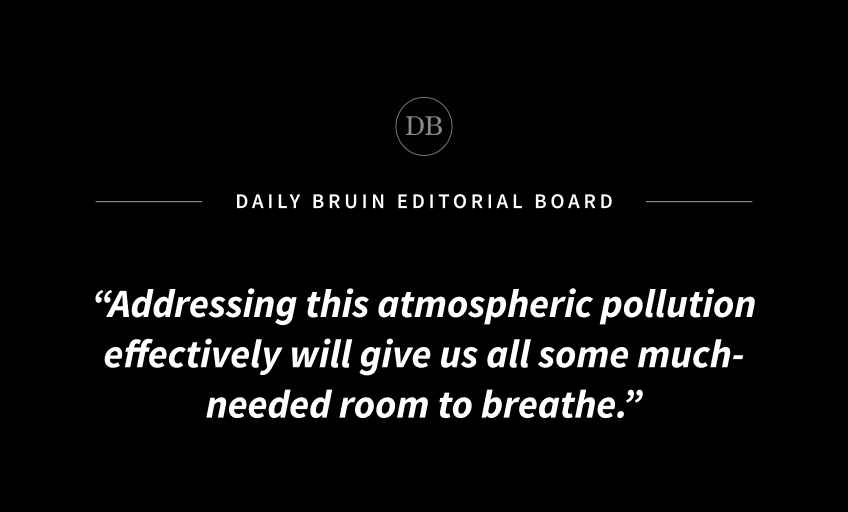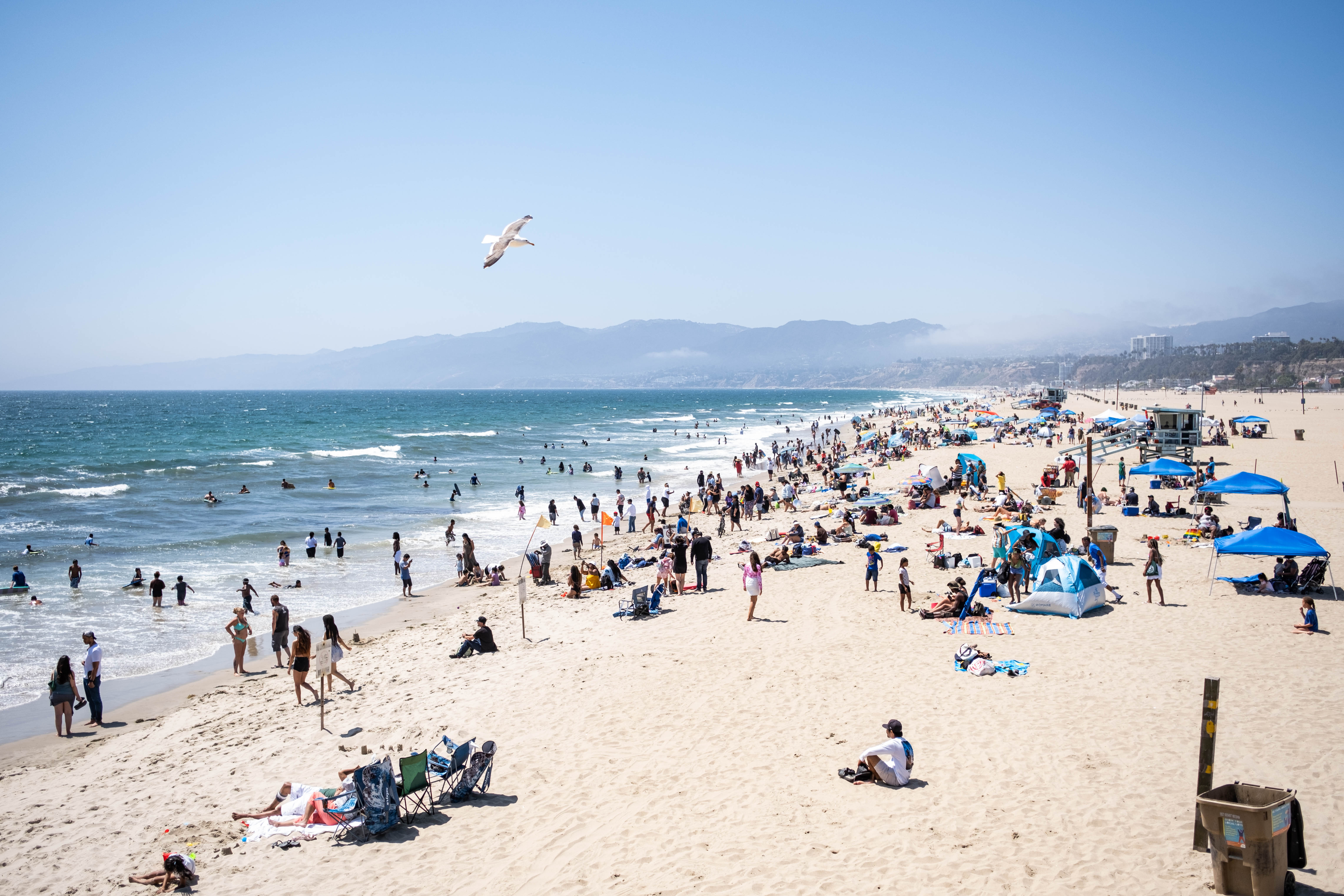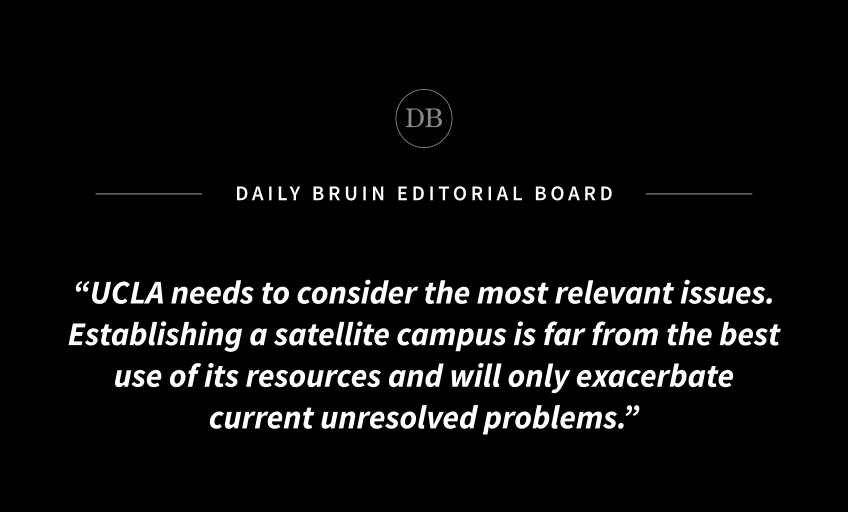Editorial: LA’s failure to adequately address air pollution threatens health of community

By Editorial Board
May 15, 2023 11:21 a.m.
This post was updated May 16 at 8:35 p.m.
Editor’s note: Editorials do not represent the views of the Daily Bruin as a whole. The Board encourages readers to respond to our editorials at dailybruin.com/submit.
The greater Los Angeles area has the worst air pollution in the country, and it’s long past time for our elected leaders to address it.
In April, the American Lung Association released a new “State of the Air” report, which examined ozone pollution across the United States. According to the study, the LA-Long Beach area had the most ozone pollution, with 177 high ozone days between 2019 and 2021, good for an “F” grade on the report. While this is a decline of about 50 days since 1996, the number of days with unhealthy ozone levels has actually risen since 2013.
The report measured the levels of pollution in U.S. cities through a weighted average of the number of days in which the ozone level exceeded the ambient national average of 70 parts per billion – beyond which is hazardous for health.
Ozone, a molecule composed of three oxygen atoms, is perhaps most well-known for forming a layer in the stratosphere that protects Earth’s surface from the sun’s intense ultraviolet radiation.
When closer to the ground, however, ozone is a potentially dangerous gas that can make it difficult to breathe, permanently damage the lungs and worsen conditions such as asthma or bronchitis. For those who are most at risk, including children, the elderly and those with preexisting conditions, exposure to high amounts of ozone is particularly likely to cause or aggravate respiratory infections and other illnesses.
Some studies have even linked high ozone levels to substantial populationwide increases in respiratory-related deaths.
The LA-Long Beach area was also ranked the fourth-worst and ninth-worst metro area for annual particle pollution and 24-hour particle pollution, respectively.
The consequences of air pollution also disproportionately affect communities of color and people with lower incomes. According to the report, people of color were 3.7 times more likely to live in counties that received failing grades on all of the report’s measures.
LA has consistently ranked dead last in the nation for ozone pollution for almost a quarter of a century, despite government efforts through the Clean Air Act and other laws to address the threats that ozone poses. The infamous smog that frequently envelops the city is principally made up of this ground-level ozone.
That this massive metropolis is heavily polluted is nothing new. But the fact that LA’s air quality has been consistently ranked among the lowest in the nation for so long is clear evidence that our local officials need to take decisive action.
Ground-level ozone is created mostly by sun-induced reactions with other pollutants, including hydrocarbons and nitrogen oxides, emitted in the air from a variety of sources.
Addressing these emissions, whether from cars and other forms of transportation or industrial processes, must be a priority if LA wants to ensure the health and safety of its inhabitants.
To some extent, however, the air pollution issues that LA faces cannot solely be addressed at the local or state levels.
While local regulations on cars and the introduction of catalytic converters have helped to reduce emissions substantially, the air pollution from other forms of transportation, including trains, planes and ships, is regulated at the federal level and is rising in the LA metropolitan area.
The massive ports in LA and Long Beach, in particular, are the single largest producers of smog-related emissions in the region. Together, they emit about 100 tons of smog and nitrogen oxides every day, more than all the emissions from cars in the area combined.
The situation has become so dire that the South Coast Air Quality Management District, which regulates air quality in Southern California, is suing the Environmental Protection Agency, arguing that the EPA’s lack of emissions standards for these other forms of transportation has made reaching the region’s clean air targets impossible.
Fulfilling these emissions goals, which were first set during former President Bill Clinton’s administration, is particularly important because they are tied to federal funding for transportation and other programs in the region. Without sufficient federal support, LA may very well prove unable to address the continued dangers that ozone and other pollutants present to the city’s public health.
While there has been some positive progress toward these emissions targets at the local level – including the recent passage of the Advanced Clean Fleets Regulation, which will help make California’s trucks and buses emissions-free by 2035 – there is still much to be done.
The current clean air program for Southern California has a price tag of about $14 billion and is supposed to run until 2031. However, only about a quarter of the program’s funding has been reached, leaving serious questions about its future.
Beyond transportation, however, the local government can also take other steps to reduce emissions, including the addition of greenery and tree-planting initiatives to boost the natural processes that regulate the concentration of these harmful particles in the air.
Particularly as climate change will continue to create hot weather conditions that make low-level ozone and smog more common, it is clear that government dysfunction cannot be allowed to continue undermining the push for clean air in our city.
Addressing this atmospheric pollution effectively will give us all some much-needed room to breathe.




